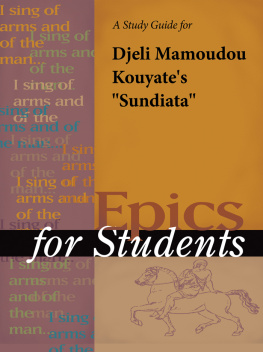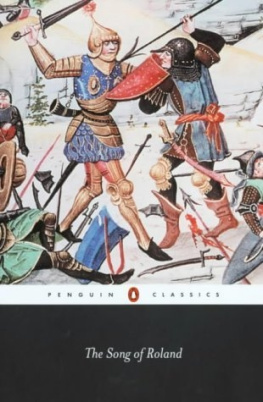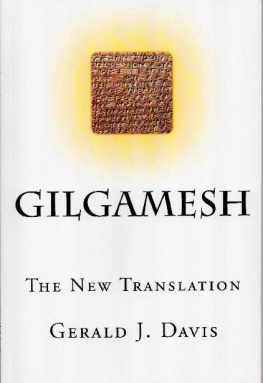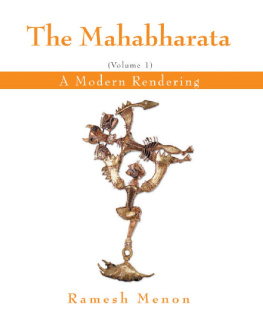TABLE OF CONTENTS
Guide
Epics for Students, Second Edition, Volume 2
Project Editor: Sara Constantakis
Rights Acquisition and Management: Margaret Chamberlain-Gaston, Savannah Gignac, Tracie Richardson, Jhanay Williams
Composition: Evi Abou-El-Seoud
Manufacturing: Drew Kalasky
Imaging: John Watkins
Product Design: Pamela A. E. Galbreath, Jennifer Wahi
Content Conversion: Katrina Coach
Product Manager: Meggin Condino
2011 Gale, Cengage Learning
ALL RIGHTS RESERVED. No part of this work covered by the copyright herein may be reproduced, transmitted, stored, or used in any form or by any means graphic, electronic, or mechanical, including but not limited to photocopying, recording, scanning, digitizing, taping, Web distribution, information networks, or information storage and retrieval systems, except as permitted under Section 107 or 108 of the 1976 United States Copyright Act, without the prior written permission of the publisher.
Since this page cannot legibly accommodate all copyright notices, the acknowledgments constitute an extension of the copyright notice.
For product information and technology assistance, contact us at Gale Customer Support, 1-800-877-4253.
For permission to use material from this text or product, submit all requests online at www.cengage.com/permissions.
Further permissions questions can be emailed to permissionrequest@cengage.com
While every effort has been made to ensure the reliability of the information presented in this publication, Gale, a part of Cengage Learning, does not guarantee the accuracy of the data contained herein. Gale accepts no payment for listing; and inclusion in the publication of any organization, agency, institution, publication, service, or individual does not imply endorsement of the editors or publisher. Errors brought to the attention of the publisher and verified to the satisfaction of the publisher will be corrected in future editions.
Gale
27500 Drake Rd.
Farmington Hills, MI, 48331-3535
ISBN-13: 978-1-4144-7621-6 (set)
ISBN-13: 978-1-4144-7622-3 (vol. 1)
ISBN-13: 978-1-4144-7623-0 (vol. 2)
ISBN-10: 1-4144-7621-3 (set)
ISBN-10: 1-4144-7622-1 (vol. 1)
ISBN-10: 1-4144-7623-X (vol. 2)
This title is also available as an e-book.
ISBN-13: 978-1-4144-7624-7
ISBN-10: 1-4144-7624-8
Contact your Gale, a part of Cengage Learning sales representative for ordering information.
Printed in the United States of America
1 2 3 4 5 6 7 14 13 12 11 10
Sundiata
Djeli Mamoudou Kouyate
Introduction
This tale tells of the great thirteenth-century ruler of Mali, Sundiata. The story has been passed down through the centuries from a long line of oral historians, or griots, who are charged with keeping the memories of the past alive. Once only available to those who could understand the native language of the griot, which in the case of Sundiata is Mandekan, the Sundiata intrigued Mali historian Djibril Tamsir Niane. He transcribed the words of the griot Djeli Mamoudou Kouyatand produced a French translation in 1960. (Naming the people and their language, from which this epic comes, is a difficult matter. This entry uses Malinke as the name for the people and Mandekan for the name of their language, following the preference of John William Johnson, a translator of the epic and folklore scholar.) An English translation by G. D. Pickett appeared, which first appeared in 1965, was published by Longman in a revised edition in 2006.
The Sundiata illustrates the anthropological importance of saving the words of the oral historians before the advent of literacy extinguishes their memories. The griots and many other oral historians work for a particular patron, and as the patronage system falls into decline, these taleweavers are less and less able to support themselves with their words. The significance of these oral historians is underlined in the epic itself: A griot plays an important role in helping Sundiata defeat his enemy Soumaoro.
In addition, the story of Sundiata contains important lessons for people of all times. For example, it cautions that appearances can be deceiving: Sundiata's physically repulsive mother becomes an honored queen, and Sundiata himself overcomes a severe handicap to become a great warrior. Another lesson is that hospitality pays, as those rulers who receive Sundiata well during his period as an outcast are rewarded under his reign. Above all, readers learn to respect their own history and ancestors, for they are the link to their past and to their own identity.
Author Biography
The story of Sundiata, the thirteenth-century ruler of Mali, was preserved through the patriarchal line of griots, bards whose function in their society is to preserve the oral history of their people. This account was told from father to son for generations. It was first written down by the historian Djibril Tamsir Niane (b. 1932), who transcribed the story as it was recounted by Djeli Mamoudou Kouyat.
The stories told by griots are not fixed in the way that written texts are: Each recitation or performance may include additions or deletions and can feature embellishment of some episodes and the downplaying of others. The griot may choose to play up the accomplishments of the distant ancestors of audience members as a sign of respect or to ensure that they will like what they are hearing. Thus, while the basic story derives from multiple storytellers who shaped it over time, the version that Niane wrote down is distinctly that of Kouyat. Kouyat is a modern day griot of the Keita clan, which claims descent from Sundiata himself. Niane made the work available to a wide audience by publishing his version in French, and G. D. Pickett later translated the work into English. Pickett also collated his translation with the original Mandekan spoken by Kouyat.
Plot Summary
Part I: The Buffalo Woman
After giving his lineage and justifying his right to tell the tale, the narrator begins the story of Sundiata by telling how Sundiata's mother and father came to be married. Sundiata's father, Maghan Kon Fatta, rules Mali. He has one wife, Sassouma Brt, and a son named Dankaran Touman. One day a hunter comes to Maghan Kon Fatta's court, bringing part of his catch in homage to the ruler, as was customary. The king asks the hunter, who is also a fortuneteller, to throw his cowry shells in a divination ceremony to reveal the future. Speaking in obscure language, the hunter reveals that the king's successor is not yet born and that his heir will come from a hideous woman brought by two strangers.
Media Adaptations
- The story of Sundiata is told in part by a master griot in the film Keita! The griot teaches a young boy his own worth by sharing with him the story of his ancestor, Sundiata. The 1994 motion picture directed by Dani Kouyat is available on video cassette from California Newsreel. The film is in Jula and French with English subtitles.





















